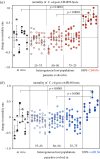Host heterogeneity mitigates virulence evolution
- PMID: 31992149
- PMCID: PMC7013476
- DOI: 10.1098/rsbl.2019.0744
Host heterogeneity mitigates virulence evolution
Abstract
Parasites often infect genetically diverse host populations, and the evolutionary trajectories of parasite populations may be shaped by levels of host heterogeneity. Mixed genotype host populations, compared to homogeneous host populations, can reduce parasite prevalence and potentially reduce rates of parasite adaptation due to trade-offs associated with adapting to specific host genotypes. Here, we used experimental evolution to select for increased virulence in populations of the bacterial parasite Serratia marcescens exposed to either heterogeneous or homogeneous populations of Caenorhabditis elegans. We found that parasites exposed to heterogeneous host populations evolved significantly less virulence than parasites exposed to homogeneous host populations over several hundred bacterial generations. Thus, host heterogeneity impeded parasite adaptation to host populations. While we detected trade-offs in virulence evolution, parasite adaptation to two specific host genotypes also resulted in modestly increased virulence against the reciprocal host genotypes. These results suggest that parasite adaptation to heterogeneous host populations may be impeded by both trade-offs and a reduction in the efficacy of selection as different host genotypes exert different selective pressures on a parasite population.
Keywords: Caenorhabditis elegans; Serratia marcescens; host heterogeneity; monoculture; parasite evolution; virulence.
Conflict of interest statement
We declare we have no competing interests.
Figures


References
-
- Ebert D, Bull JJ. 2008. The evolution and expression of virulence. In Evolution in health and disease (eds Stearns SC, Koella JC), pp. 153–168. Oxford, UK: Oxford University Press; (10.1093/acprof:oso/9780199207466.003.0012) - DOI
Publication types
MeSH terms
Associated data
LinkOut - more resources
Full Text Sources
Other Literature Sources
